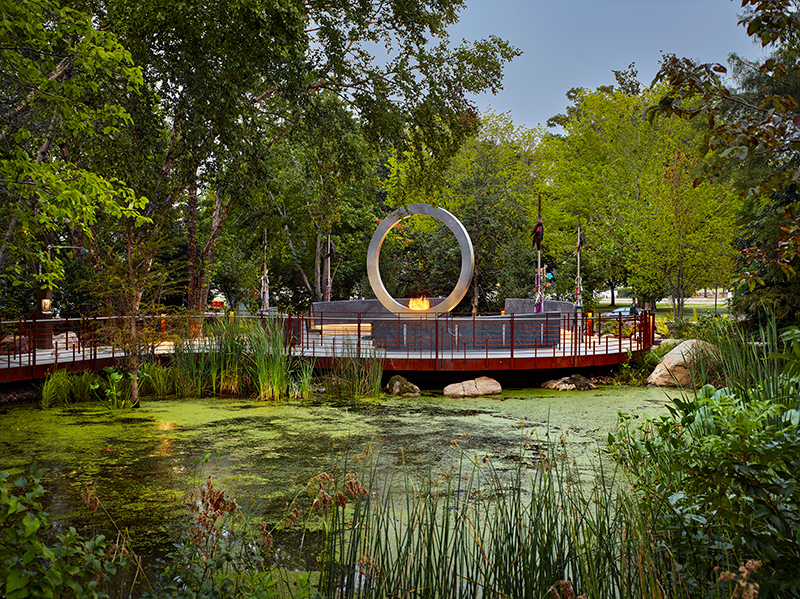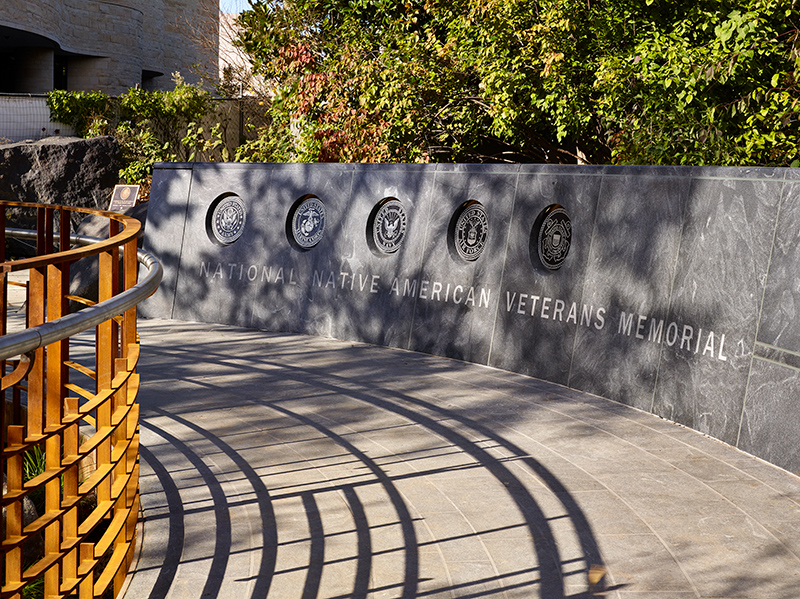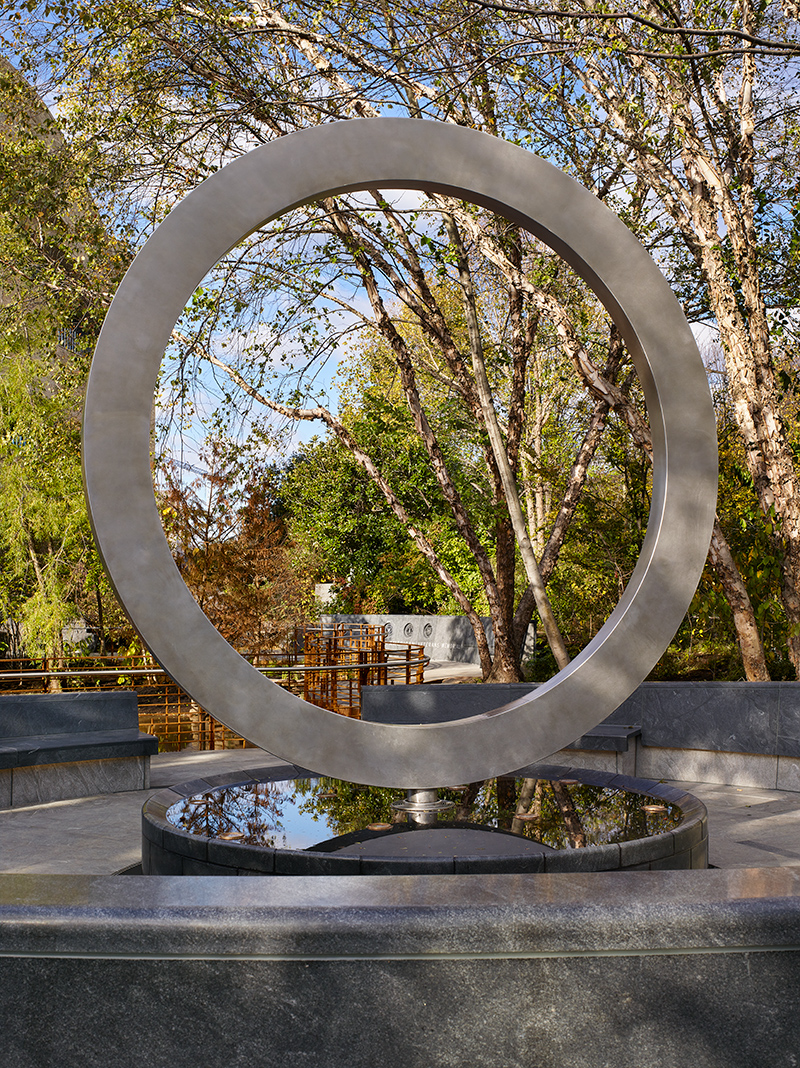
NATIONAL NATIVE AMERICAN VETERANS MEMORIAL
Honoring the Military Service of Native Americans
The National Native American Veterans Memorial opened on November 11, 2020, on the grounds of the National Museum of the American Indian in Washington, DC. The memorial was dedicated with a procession and ceremony on the National Mall on November 11, 2022. This tribute to Native heroes recognizes for the first time on a national scale the enduring and distinguished service of Native Americans in every branch of the US military.

Visit the Memorial
Memorial | Every day, 24 hours a day
Museum | Daily 10 AM–5:30 PM, except December 25
Memorial FAQ
Memorial Design
An elevated stainless-steel circle balanced on an intricately carved stone drum, the design of the National Native American Veterans Memorial is simple and powerful, timeless and inclusive. The design incorporates water for ceremonies, benches for gathering and reflection, and four lances where veterans, family members, tribal leaders, and others can tie cloths for prayers and healing. The memorial creates an interactive yet intimate space for gathering, remembrance, reflection, and healing. It welcomes and honors Native American veterans and their families, and educates the public about their extraordinary contributions.
Memorial Designer
A distinguished group of Native and non-Native jurors unanimously selected the design concept Warriors’ Circle of Honor by Harvey Pratt (Cheyenne and Arapaho Tribes of Oklahoma) from among more than 120 submissions. Pratt is a self-taught artist whose works include themes of Native American history and tradition and the Cheyenne people. Born in El Reno, Oklahoma, Pratt credits his parents and teachers for encouraging his artistic pursuits and respect for veterans. A veteran himself, Pratt served in Vietnam from 1962 to 1965 as a US Marine in Air Rescue and Security stationed at Da Nang Air Base. He is recognized by the Cheyenne People as an outstanding Southern Cheyenne, and was inducted as a traditional Peace Chief—the Cheyenne Nation’s highest honor.
Online Exhibition
Visit the museum’s online exhibition Why We Serve: Native Americans in the United States Armed Forces.
American Indian Magazine
Explore the commemorative issue featuring this enduring tribute to Native veterans.
Tell Your Story
In partnership with the National Museum of the American Indian, the Veterans History Project of the Library of Congress’s American Folklife Center collects and preserves the unique stories of Native men and women who have served in the military through interviews, correspondence, and photographs.
FAQ | Memorial
Visiting the memorial
When can I visit the memorial?
The memorial is open every day, 24 hours a day.
Is there an admission fee?
No. Entry to the memorial is free.
Do I need a ticket or pass to enter the memorial?
No. Tickets are not required to visit the memorial.
Where do I sign up for tours?
Tours are not available at this time.
How does my tribe schedule a ceremony at the memorial?
Private ceremonies or visits to the memorial cannot be scheduled at this time. The museum is operating with a reduced staff and cannot assist you with the arrangements necessary for a ceremony. Should you like to conduct a ceremony at the memorial, you must adhere to capacity and social distancing guidelines. Please note that we cannot guarantee any privacy for the ceremony, since the memorial is open to the public.
Can I host a promotion, retirement, or other military ceremony at the memorial?
Individuals and groups may host ceremonies at the memorial, though the museum cannot schedule private ceremonies or private visits to the memorial nor assist visitors with the arrangements necessary for a ceremony. Should you like to conduct a ceremony at the memorial, you must adhere to capacity guidelines. Please note that the museum cannot guarantee any privacy for the ceremony, since the memorial is open to the public.
When will I be able to see the memorial’s ceremonial flame?
The museum lights the flame on Veterans Day and Memorial Day and other occasions that honor the sacrifice and service of Native veterans.
May I schedule a private visit to the memorial?
The museum cannot schedule private visits to the memorial at this time. The museum is operating with a reduced staff and cannot assist you with arranging a private visit.
May I borrow or rent a wheelchair when I arrive on site?
The museum has a limited number of wheelchairs available free on a first-come, first-served basis for use inside the museum, but they may not be used outdoors at the memorial. Wheelchair and scooter rental is available through local vendors.
What items are permitted and prohibited when visiting the memorial?
Please note that while on Smithsonian property, no visitor shall carry firearms, other dangerous or deadly weapons, or explosives, either openly or concealed on the premises. The prohibition on firearms applies to all visitors, including those with firearm permits, but not to active law enforcement personnel authorized to carry firearms. Certain ceremonial items that may be considered weapons will need to be reviewed upon arrival. Sharp edges, points, or blades on weapons must be covered with protective material.
These security measures ensure visitor safety as well as the protection of objects in the museum. View a list of permitted and prohibited items in the museum. If you are planning to visit other Smithsonian museums during your time in Washington, DC, please visit the Smithsonian Institution’s website for additional tips for visiting.
Will Veterans/Tribes/Native Nations be listed on the memorial?
No. Throughout the memorial design consultation process, the museum found that many Native veterans consulted did not wish to include tribal identification and/or names of Native veterans on the memorial. Since the memorial is timeless and dedicated to all Native veterans—past, present, and future—names and specific tribal identification are not included in the design.
Memorial design
Who designed the memorial?
The National Native American Veterans Memorial was designed by Harvey Pratt, a member of the Cheyenne and Arapaho Tribes of Oklahoma and a Southern Cheyenne Peace Chief. Pratt is an artist, Marine Corps Vietnam veteran, and retired forensic artist. Pratt designed the memorial in partnership with award-winning architectural firm Butzer Architects and Urbanism.
The design goals for the memorial grew out of an extensive outreach and consultation process. Beginning in 2015, the museum worked with the National Congress of American Indians and other Native organizations to create an advisory committee composed of tribal leaders, Native veterans, and their family members to assist with outreach to Native American communities and veterans. The museum and advisory committee conducted 35 community consultations across the nation to seek input and support for the memorial. These events resulted in a shared vision and set of design principles that informed the competition.
In 2017, the museum launched an international competition for the memorial’s design. More than 120 proposals from across the globe were submitted. In 2018, eight distinguished jurors selected five concepts by six finalists (James Dinh, the team of Dan Jones and Kelly Haney, Harvey Pratt, Stefanie Rocknak, and Leroy Transfield). Later that year, the competition concluded when the jury unanimously selected Harvey Pratt’s design, the Warriors’ Circle of Honor.
What is the meaning of symbolism incorporated in the memorial’s design?
The focal point of the memorial is a large, vertical stainless-steel circle, sitting atop a low, carved stone drum form, at the center of a circular gathering space. Water flows continuously outward from the center of the drum, and a fire may be lit at the base of the steel circle on ceremonial occasions. A circular seating area may be entered at the four cardinal directions from a surrounding walkway called the Path of Harmony, respecting different cultural practices regarding the appropriate direction from which to enter the central space. There are four vertical spears or lances where visitors may leave prayer ties. The seals of the five branches of the armed forces are on a nearby wall.
The memorial is set within the living landscape to the east of the museum, at the edge of the upland hardwood forest, overlooking the freshwater wetland. A meandering walkway known as the Path of Life leads visitors to the memorial, allowing them time to prepare themselves as they approach it. Veterans and families expressed a preference for a quiet place on the grounds of the museum. The trees surrounding the memorial and the water nearby help to separate it from the noise and traffic of the city.
The memorial is meant to be timeless and inclusive, honoring all Native American, Alaska Native, and Native Hawaiian veterans, as well as the families who support them. The circular design suggests a sacred circle, the cycles of time and life, and the movement of the stars and planets. The circle is relevant to many Native American cultures in the shape of a drum and of circles for dance, storytelling, and prayer. The memorial incorporates the elements of fire, representing strength, courage, endurance, and comfort; water, signifying purification and prayer; earth, which provides people with all they need; and the wind that will carry the prayers and memories of visitors skyward.
The water pulsing across the surface of the drum is echoed by concentric rings in the stone of the walkways, suggesting the beat of a drum calling people to gather within the circle. The National Native American Veterans Memorial is a welcoming space for gathering, reflection, healing, and remembrance, a place to honor the sacrifices and service of generations of Native veterans.
What are prayer cloths?
Prayer cloths are used by many Native people as a symbol of their spirituality. Some may contain tobacco and be tied as a bundle. Others are strips of cloth. They should not be touched or removed by visitors.
What is the music I hear when I enter the memorial?
Playing on a continuous loop are thirteen Native American veteran songs from the Ojibwe, Menominee, Blackfeet, Ho-Chunk, Kiowa, and Lakota Nations from the Smithsonian Folkways recording, American Warriors: Songs for Indian Veterans.
Leaving offerings or other artifacts
Is the museum collecting Native veterans’ artifacts?
The NMAI accepts donations of items that enhance its permanent collections; not all objects offered for donation are accepted. To submit a donation or purchase offer to the NMAI, complete and submit an Acquisition Proposal and attachments for consideration. Please do not bring the item(s) that you want to donate to the memorial. The NMAI does not keep or acquire any items left at the memorial.
Can offerings like tobacco be left at the memorial?
The NMAI does not keep or acquire any offerings left at the memorial. Offerings left are disposed of respectfully in an appropriate manner, including Native American cultural practices for organic offerings. No offerings are photographed, catalogued, or otherwise documented by the NMAI.
Can I bring a prayer cloth?
Yes. When tying a prayer cloth to the memorial, please do not touch or remove other prayer cloths that have been attached before yours.
History
Why did the National Museum of the American Indian (NMAI) build a memorial?
In 2013, Congress passed legislation authorizing the NMAI to create a National Native American Veterans Memorial to give "all Americans the opportunity to learn of the proud and courageous tradition of service of Native Americans in the Armed Forces of the United States."
How was the memorial funded?
The legislation from Congress did not allow for any federal funding to be used for the construction of the memorial. Funding for the memorial came from individuals, organizations, and Native Nations. We gratefully acknowledge their generosity and commitment to the National Native American Veterans Memorial project.
Staying Connected
How do I learn more about the memorial?
Continue to visit this site for the latest information. For additional information, please contact the Office of Special Events, National Museum of the American Indian, at NNAVMDedication@si.edu or 202-633-7020.





